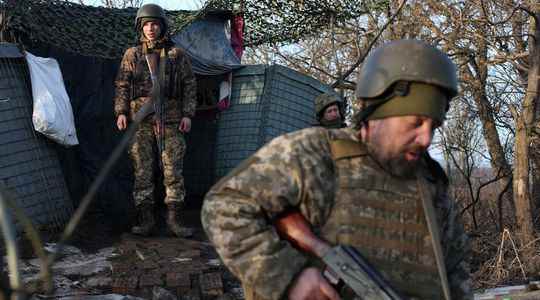“The combat capabilities of the Ukrainian forces [ont] been significantly reduced, allowing […] to concentrate the bulk of the efforts on the main objective: the liberation of Donbass.” This is how Sergei Roudskoy, Deputy Chief of the Russian General Staff, announced on Friday March 25 a reorientation of the armed forces to the east of the country, on the 31st day of the invasion of Ukraine.
But like the number of dead posted by Moscow – 1,351 and 3,825 injured, much less than the figures put forward by American intelligence or the Ukrainian authorities -, “it is not at all certain that we should take at the foot of the letter what the Russian army tells us”, assures François Heisbourg, president of the International Institute for Strategic Studies (IISS) and special adviser for the Foundation for Strategic Research (FRS).
L’Express: What does this statement tell us about Russia’s current strategy?
Francois Heisbourg: In this statement from the Russian Defense Ministry, there are two phases. This tells us that phase one ended, essentially on a success since Russia never intended to take the cities of kyiv, Kharkiv… This forces us to wonder about the meaning of the phase two. If the phase one communication is from bullshit [NDLR : “foutaises”, argot américain], which it is, obviously, we must first know if the description of phase two is not also. This is the first precaution to take.
But what could this mean in practice, on the ground?
First, Russia is forfeiting its operations in most of the territory in which it has operated until now. It is information in itself. Secondly, in order to be able to concentrate on the Donbass, one must have enough to concentrate on. Once again, it is not at all sure that we should take at face value what the Russian army tells us.
Today, as everywhere else, there is intense fighting in the Donbass region. Russian advance was limited from the early days of the invasion. In the last there were very strong attempts to take the city of Izioum [NDLR : une ville de l’oblast de Kharkiv], a strategic crossroads. But according to the images we receive from there, the Russian troops were beaten.
What are the Ukrainian forces in this region?
The system around the parts of Donbass occupied since 2014 is essentially intact. Some of the best Ukrainian forces are concentrated there. The land has been laid out, it’s trench warfare. It is therefore a bit complicated for the Russians, in the state they are in, to wage an effective war against a trained and motivated enemy. To do something new in the Donbass, you have to bring troops there, who are on the side of kyiv, Kharkiv, Kherson… In Kherson, they are not really in a condition to go anywhere, the Ukrainians making a counter-offensive. And everyone is running out of ammunition, fuel, food. I don’t know how they could get to Donbass.
I don’t know if this phase two is a way to reduce the tempo of operations to where they were in 2014 – status quo or something like that – or if it means that they will actually attempt an operation that many Many analysts expected the start of the war to be an encirclement of Ukrainian troops stationed around the two so-called breakaway republics. What can the Russians do to flesh out a phase two that in some ways would be more difficult to conduct than phase one?
In the Donbass, we are dealing with Ukrainian soldiers who have been fighting for eight years. They are probably more difficult to manage than people from the territorial militia who arrive after three days of learning how to handle weapons. I therefore take the announcement of this phase two as an element of communication. One can only deduce from this that the Ministry of Russian forces takes note of the fact that its troops are no longer advancing anywhere.
Is this also a way of reorienting itself to ensure the territorial continuity between Crimea and Russia, wanted by Putin?
But that’s not what the Russians say, that the effort is concentrated on Tauride – the Greek name given to this territory between the Crimea and the Donbass, which the Russians call Novorossia (“New Russia”) -, where lies the city of Mariupol, at the junction of the two. I’m not excluding at all that they do, but that’s not what is stated. The Russians say they are concentrating on the Donbass. Today, they largely occupy Donetsk Oblast. There is not much to demonstrate here. On the other hand, there remains a large piece to be taken in the Lugansk oblast.
The strategic goal is a priori the encirclement of the 40,000 Ukrainian soldiers who are positioned there. This is an operation whose purpose is military rather than territorial. Unlike taking the Tauride strip of land, which would be a territorial goal. The Russians pursued him and they could, if necessary, continue to pursue him. But we can clearly see that at one end of the chain, in Kherson, things are not going well for them. In Berdyansk, in the south-east of Ukraine, the Russian navy has had half of its amphibious transport capacity decimated. The coastal strip is visibly held sparsely. He remains Mariupol: according to the Russian press release, his “liberation” did not take place. They may take Mariupol, but in such a state that I don’t see what they could do with it.
In general, Putin works for the long term. For him, the difficulties of the Russian army are a very bad time to pass, but he does not give up, at least for the moment, on his initial objective of breaking Ukrainian political power by waging a victorious war.
